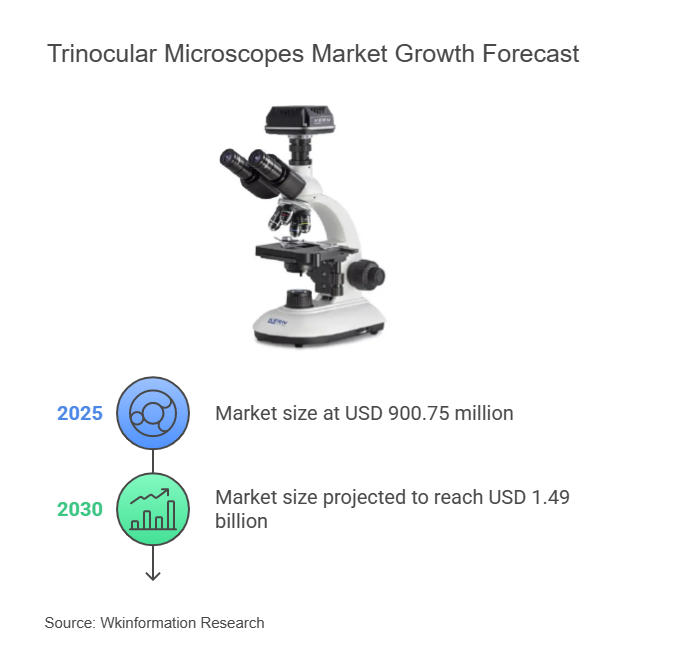
The trinocular optical microscope market is poised for significant growth in 2025, driven by advancements in technology and increasing demand across industries. Regional analysis highlights Asia-Pacific as a key contributor to market expansion, while segmentation by type and application identifies lucrative opportunities. Current trends, such as the integration of artificial intelligence and digital imaging, are reshaping market dynamics. These microscopes play a pivotal role in life sciences, diagnostics, and industrial applications, making them indispensable tools for precision research and innovation.
Key Insights
- The trinocular microscope market may grow from $900.75 million in 2025 to $1.49 billion by 2033 because of new technology.
- Important users of these microscopes are healthcare, biotech, and materials science industries. They are crucial for research and medical tests.
- New technologies like AI and digital imaging improve these microscopes. They are now easier to use and work better.
- The Asia-Pacific area is growing fast in this market. This is due to more research funding and demand for better tools.
- Problems like high prices and limited access in poorer areas exist. However, nanotechnology and research funding can help the market grow.

Market Overview
Market Size and Growth Rate
The trinocular optical microscope market has experienced steady growth over the years, with significant expansion projected in the coming decade. In 2025, the market size stood at USD 900.75 million, and it is forecasted to reach USD 1.49 billion by 2033, reflecting a robust compound annual growth rate (CAGR) of 6.5% from 2025 to 2033. This growth trajectory highlights the increasing adoption of advanced microscopy solutions across various sectors.
The market’s upward trend is driven by technological advancements and the rising demand for precision tools in research and industrial applications. These factors underscore the importance of the trinocular optical microscope market in shaping future innovations.
Key Drivers of Growth
Several factors contribute to the growth of the optical microscope market. The growing demand for advanced microscopy techniques, such as live-cell imaging and super-resolution microscopy, has fueled the adoption of trinocular microscopes. Significant investments in healthcare and life sciences have also played a pivotal role. Research and development efforts in drug discovery and medical diagnostics require high-quality imaging tools, further boosting demand.
Technological advancements have enhanced the performance of trinocular microscopes, offering higher resolution and improved imaging capabilities. These innovations have made them indispensable in fields like biotechnology, pharmaceuticals, and materials science. Additionally, the market benefits from the rising interest in sustainable solutions, particularly in manufacturing and healthcare sectors.
Applications Across Industries
Trinocular optical microscopes find applications across a wide range of industries. In healthcare, they are essential for medical diagnosis and examining biological specimens. Research institutes rely on these microscopes for scientific studies in cell biology and microbiology. Academic institutions use them for educational training, providing students with hands-on experience in microscopy techniques.
In biotechnology and pharmaceuticals, trinocular microscopes play a critical role in drug discovery and quality control processes. Materials science also leverages these tools to analyze material properties and structures. Other industries, such as automotive and consumer electronics, utilize these microscopes for innovation and quality assurance. The versatility of trinocular microscopes ensures their continued relevance in diverse fields.
Trends in the Trinocular Optical Microscope Market

Technological Advancements
Integration of AI and Digital Imaging
The trinocular optical microscope market is witnessing a surge in technological innovations, particularly in artificial intelligence (AI) and digital imaging. AI integration enhances data analysis by automating image interpretation, reducing human error, and improving accuracy. Digital imaging systems allow advanced image capture and analysis, enabling researchers to achieve higher precision in their work. These advancements are transforming the trinocular biological microscope market, making it indispensable for applications requiring detailed imaging and analysis.
| Advancement Type | Description |
|---|---|
| Digital Integration | Integration with digital imaging systems for advanced image capture. |
| Artificial Intelligence | AI streamlines data analysis and improves image interpretation accuracy. |
| Advancements in Optics | Enhanced lenses and coatings improve image clarity and resolution. |
| Portable and Compact Designs | Demand for compact designs supports field research and portability. |
| Customization Options | Tailored solutions meet specific research and industrial needs. |
User-Friendly and Ergonomic Designs
Manufacturers are prioritizing user-friendly designs to enhance usability and comfort. Ergonomic features, such as adjustable eyepieces and lightweight structures, reduce strain during prolonged use. These designs cater to the rising demand for accessible and efficient tools in the trinocular optical microscope market. Compact and portable models are also gaining traction, especially for fieldwork and on-site research.
Demand in Life Sciences
Role in Diagnostics and Medical Research
The trinocular biological microscope market plays a critical role in diagnostics and medical research. These microscopes are essential for examining tissue samples and blood smears, aiding in the diagnosis of chronic diseases. Hospitals, diagnostic laboratories, and research institutes increasingly rely on these tools for high-resolution imaging in cell biology and microbiology.
Applications in Pharmaceuticals and Biotechnology
Pharmaceutical and biotechnology industries utilize trinocular microscopes for drug discovery and quality control. These tools enhance research capabilities by providing detailed imaging for molecular biology studies. Academic institutions also benefit from these microscopes, supported by investments in STEM education. The electronics industry further leverages them for quality assurance, ensuring precision in manufacturing processes.
Regional Growth Trends
Expansion in Asia-Pacific
The Asia-Pacific region is emerging as a significant contributor to the trinocular optical microscope market size forecast. Rapid industrialization and urbanization drive demand for advanced microscopy tools. Countries like China and India are investing heavily in research and development, boosting market opportunities in the region.
Growth in North America and Europe
North America and Europe maintain strong positions in the trinocular biological microscope market due to robust infrastructure and high purchasing power. These regions benefit from technological advancements and rising consumer expectations. Government support and increased funding for scientific research further fuel growth, ensuring a steady demand for high-quality optical microscopes.
Market Segmentation in the Optical Microscope Market
By Product Type
Upright Trinocular Microscopes
Upright trinocular microscopes dominate the trinocular biological microscope market due to their versatility and widespread use in laboratories and research facilities. These microscopes are ideal for observing specimens on slides, making them indispensable in biological and medical research. Their ergonomic design and advanced imaging capabilities cater to the rising demand for precision tools in diagnostics and life sciences.
Inverted Trinocular Microscopes
Inverted trinocular microscopes are gaining traction in the trinocular optical microscope market size forecast. These microscopes are specifically designed for observing specimens in liquid media, such as cell cultures. Their unique configuration allows researchers to study living cells without disrupting their environment. This feature makes them a preferred choice in biotechnology and pharmaceutical industries, where live-cell imaging is critical.
By Application
Research and Academic Institutions
Trinocular optical microscopes play a pivotal role in research and academic institutions. They enhance learning experiences by providing students with hands-on training in microscopy techniques. Researchers rely on these tools for detailed analysis and observation of specimens, contributing to advancements in cell biology, microbiology, and materials science. The trinocular biological microscope market benefits from increased investments in STEM education and scientific research.
Industrial and Manufacturing Sectors
The industrial and manufacturing sectors utilize trinocular microscopes for quality control and innovation. These tools enable precise inspection of materials and components, ensuring product reliability. Industries such as automotive, electronics, and aerospace leverage these microscopes to maintain high standards in production processes. The trinocular optical microscope market dynamics reflect the growing importance of these tools in industrial applications.
By Region
North America
North America remains a key player in the trinocular optical microscope market. The region’s robust infrastructure and high purchasing power drive the adoption of advanced microscopy solutions. Increased funding for scientific research and technological advancements further contribute to market growth.
Europe
Europe exhibits steady growth in the trinocular biological microscope market. The region benefits from strong government support for research and development. Academic institutions and industries across Europe continue to invest in high-quality optical microscopes, ensuring consistent demand.
Asia-Pacific
The Asia-Pacific region leads the trinocular optical microscope market size forecast. Rapid industrialization, urbanization, and technological advancements fuel market opportunities in countries like China and India. The region’s dynamic growth highlights its potential as a global hub for microscopy solutions.
Rest of the World
Emerging economies in Latin America, Africa, and the Middle East present untapped market opportunities. Increasing investments and governmental support in these regions drive the adoption of trinocular microscopes. These markets hold significant potential for future growth in the optical microscope market.
The trinocular optical microscope market segmentation highlights diverse applications and regional growth trends. This comprehensive market analysis underscores the importance of tailored solutions to meet specific industry needs.
Competitive Landscape in the Trinocular Optical Microscope Market

Leading Market Players
Overview of Major Companies and Their Market Share
The trinocular biological microscope market features several prominent players that dominate the competitive landscape. These companies leverage their expertise to deliver innovative solutions and maintain a strong foothold in the market. Key players include:
- Nikon
- Leica Microsystems
- Olympus
- Zeiss
- Bruker
- Hitachi HighTechnologies
- Mitutoyo
- Keyence
- Amscope
- Omano
- Meiji Techno
- Swift Optical Instruments
- Optilia
- Vision Engineering
- Esco Technologies
These organizations contribute significantly to the trinocular optical microscope market size forecast by offering diverse product portfolios and advanced technologies. Their market share reflects their ability to meet the growing demand for high-quality imaging tools across industries.
Innovations and Product Offerings
Leading companies in the trinocular biological microscope market focus on continuous innovation to stay competitive. They integrate cutting-edge technologies such as digital imaging and automation features into their products. These advancements enhance functionality and cater to the evolving needs of end-users. Additionally, many manufacturers prioritize user-friendly designs and ergonomic features, ensuring accessibility and comfort for researchers and professionals. Customization options further allow businesses to align their offerings with specific industry requirements, boosting customer satisfaction and market penetration.
Strategies for Growth
Investment in R&D and Product Differentiation
Investment in research and development remains a cornerstone of growth strategies in the trinocular optical microscope market. Companies allocate significant resources to develop advanced and user-friendly models that address emerging challenges in diagnostics, life sciences, and industrial applications. By focusing on product differentiation, manufacturers create unique solutions that stand out in a competitive market. This approach not only drives innovation but also strengthens brand loyalty among customers.
Partnerships and Acquisitions
Collaborative efforts play a crucial role in shaping the trinocular optical microscope market size forecast. Companies form strategic partnerships and pursue acquisitions to expand their market presence and enhance their product offerings. These alliances enable businesses to access new technologies, enter untapped markets, and strengthen their competitive position. By aligning their strategies with market forecasts, organizations ensure sustained growth and adaptability in a dynamic industry.
The trinocular biological microscope market thrives on innovation and strategic planning. Leading players continue to shape the competitive landscape by leveraging advanced technologies and fostering collaborations. These efforts underscore the market’s potential for sustained growth and development.
Challenges and Opportunities in the Market
Challenges
High Costs of Advanced Microscopes
The trinocular biological microscope market faces significant challenges due to the high costs associated with advanced systems. Manufacturing expenses for these microscopes, creating financial barriers for hospitals, laboratories, and small-scale industries. These high initial investments often deter adoption, particularly in sectors with limited budgets. Additionally, the need for skilled technicians to operate these sophisticated systems further complicates market expansion.
Limited Adoption in Developing Regions
The trinocular optical microscope market size forecast highlights limited accessibility in developing regions as a persistent challenge. Many countries in Latin America, Africa, and parts of Asia lack the infrastructure and financial resources to support widespread adoption. Regulatory hurdles and intense competition among manufacturers also hinder market penetration. These factors collectively slow the growth of the trinocular optical microscope market in emerging economies.
Opportunities
Demand for Precision Tools in Nanotechnology
The growing emphasis on nanotechnology presents a significant opportunity for the trinocular biological microscope market. Advancements in digitization and automation have increased the demand for precision tools in fabrication and logistics. Trinocular microscopes, with their ability to provide high-resolution imaging, are becoming indispensable in this field. Furthermore, the collaboration between market leaders and technology innovators is driving the development of environmentally friendly and sustainable microscopy solutions. This trend aligns with the rising demand for high-quality products among the emerging middle class in developing regions.
Increased Funding for Scientific Research
The trinocular optical microscope market size forecast indicates robust growth, driven by increased funding for scientific research. The global market is projected to grow from USD 900.75 million in 2025 to USD 1.49 billion by 2033, reflecting a CAGR of 6.5%. This growth stems from the rising demand for advanced microscopy techniques in life sciences, materials science, and semiconductors. Innovations such as AI-powered image analysis further enhance the capabilities of trinocular microscopes, making them essential tools for early disease diagnosis and cutting-edge research.
The trinocular optical microscope market continues to evolve, balancing challenges with promising opportunities. Addressing cost barriers and expanding accessibility in developing regions will be crucial for sustained growth.
Overview
The trinocular optical microscope market demonstrates immense growth potential, driven by advancements in technology and increasing demand across industries. Key trends, such as AI integration and ergonomic designs, continue to shape the market landscape. Regional growth in Asia-Pacific and steady expansion in North America and Europe highlight the global appeal of these tools.
Technological innovations and strategic investments will likely propel the market forward. As industries prioritize precision and efficiency, the market is poised to play a pivotal role in scientific research and industrial applications. The future of the market remains promising, with opportunities for innovation and expansion.
| Report Metric | Details |
|---|---|
| Report Name | Global Trinocular Optical Microscope Market Report |
| Base Year | 2024 |
| Segment by Type | · Upright Trinocular Microscopes
· Inverted Trinocular Microscopes |
| Segment by Application | · Research and Academic Institutions
· Industrial and Manufacturing Sectors |
| Geographies Covered | · North America (United States, Canada)
· Europe (Germany, France, UK, Italy, Russia) · Asia-Pacific (China, Japan, South Korea, Taiwan) · Southeast Asia (India) · Latin America (Mexico, Brazil) |
| Forecast units | USD million in value |
| Report coverage | Revenue and volume forecast, company share, competitive landscape, growth factors and trends |
FAQ
What is a trinocular optical microscope, and how does it differ from other microscopes?
A trinocular optical microscope features three viewing ports—two for binocular observation and one for attaching a camera. This design enables simultaneous visual observation and image capture, making it ideal for research, documentation, and teaching purposes.
Which industries benefit the most from trinocular optical microscopes?
Industries such as life sciences, biotechnology, pharmaceuticals, and materials science benefit significantly. These microscopes support applications like diagnostics, drug discovery, quality control, and advanced research in nanotechnology and cell biology.
Why is the Asia-Pacific region experiencing rapid growth in this market?
The Asia-Pacific region benefits from increased investments in research and development, rapid industrialization, and growing demand for advanced microscopy tools. Countries like China and India lead this growth due to their expanding scientific infrastructure.
What are the key technological advancements in trinocular optical microscopes?
Key advancements include AI integration for automated image analysis, digital imaging systems for enhanced precision, and ergonomic designs for user comfort. These innovations improve functionality and cater to diverse research and industrial needs.
Are trinocular optical microscopes suitable for educational purposes?
Yes, trinocular microscopes are widely used in academic institutions. They provide students with hands-on experience in microscopy techniques and support detailed observation, making them essential tools for STEM education and training.
Global Trinocular Optical Microscope Market Report – Table of Contents
1 Market Study Overview
2 Basic Product Information
3 Market Analysis
4 Trinocular Optical Microscope Related Market Analysis
5 Global Trend Summary
6 Competition by Manufacturer
7 Analysis of Key Players
8 Global Trinocular Optical Microscope Revenue, Sales Categorized by Regions
9 North America Trinocular Optical Microscope Market Size Categorized by Countries
10 Europe Trinocular Optical Microscope Market Size Categorized by Countries
11 Asia-pacific Trinocular Optical Microscope Market Size Categorized by Countries
12 South America Trinocular Optical Microscope Market Size Categorized by Countries
13 Middle East and Africa Trinocular Optical Microscope Market Size Categorized by Countries
14 Global Trinocular Optical Microscope Industry Segment Analysis
15 Global Trinocular Optical Microscope Market Forecast
16 Research Findings and Conclusion


